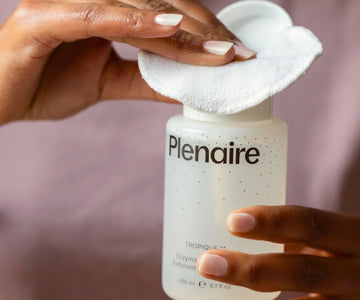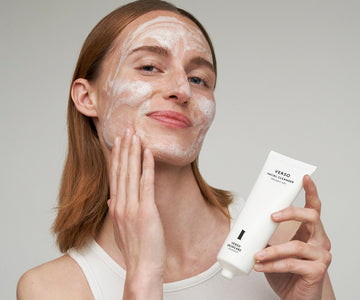
We’ve written down a pros and cons list so you can decide, which one is better for you.
What is physical exfoliation?
Physical exfoliation involves manually scrubbing your skin with abrasive substances to remove dead skin cells. Common physical exfoliants include face scrubs with granular particles like sugar or microbeads, and skincare tools like brushes or sponges. The immediate result is often satisfying, leaving the skin feeling smooth and refreshed.
Pros of physical exfoliation
- Instant gratification with visibly smoother skin.
- It is easy to control the intensity by adjusting the pressure applied.
- Widely available in various forms from scrubs to tools.
Cons of Physical Exfoliation
- Can cause micro-tears in the skin if too abrasive or used too vigorously.
- Not suitable for sensitive skin or skin conditions like rosacea or acne, as it may exacerbate irritation or breakouts.
What is chemical exfoliation?
Chemical exfoliation uses acids or enzymes to break down dead skin cells without physical scrubbing. Alpha hydroxy acids (AHAs) like glycolic acid and lactic acid are popular for their ability to exfoliate the surface layer. Beta hydroxy acids (BHAs), primarily salicylic acid, penetrate deeper into the skin to target oil glands and unclog pores.
Pros of chemical exfoliation
- Provides a deeper, more uniform exfoliation.
- Ideal for treating acne, blackheads, and skin texture issues.
- Often less abrasive than physical exfoliants, making them suitable for sensitive skin when used appropriately.
Cons of Chemical Exfoliation
- May cause sensitivity to sunlight, requiring diligent use of sunscreen.
- Potentially irritating if not chosen according to skin type or used too frequently.
- Some strong formulations may require a dermatologist’s guidance.
Which One Should You Choose?
The choice between physical and chemical exfoliation depends largely on your skin type, concerns, and preferences:
- For sensitive skin: Opt for mild chemical exfoliants like lactic acid, which is gentler and also hydrates the skin.
- For acne-prone skin: Chemical exfoliants with BHAs are preferable as they go deep into pores to clear out oil and debris.
- For mature skin: AHAs are excellent as they help with texture, pigmentation, and fine lines while stimulating collagen production.
- For immediate results: Physical exfoliants can quickly buff away flaky skin, ideal before a big event or whenever instant smoothness is desired.
It’s also possible to use both types of exfoliants in your routine, but not simultaneously. For example, you might use a gentle physical exfoliant once a week and a chemical exfoliant once or twice a week, depending on how your skin responds. Always listen to your skin and adjust your exfoliation routine to avoid over-exfoliation, which can lead to irritation and compromised skin barrier.
Whether you choose physical or chemical exfoliation, both can be effective when used correctly. The key is to tailor your choice to your skin’s needs and always follow up with a good moisturizer and sunscreen to maintain skin health and protection.






















